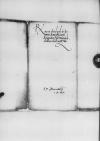In causa serenissimi Christian III of Oldenburg (*1503 – †1559), 1534-1559 King of Denmark and Norway, 1523-1559 Duke of Holstein and Schleswig; son of Frederick I of Oldenburg, King of Denmark, and his first consort, Anna of Brandenburg⌊regis DanorumChristian III of Oldenburg (*1503 – †1559), 1534-1559 King of Denmark and Norway, 1523-1559 Duke of Holstein and Schleswig; son of Frederick I of Oldenburg, King of Denmark, and his first consort, Anna of Brandenburg⌋ quid factum est, ex cf. Sigismund I Jagiellon to Ioannes DANTISCUS Cracow, 1540-01-04, CIDTC IDL 2266⌊litteriscf. Sigismund I Jagiellon to Ioannes DANTISCUS Cracow, 1540-01-04, CIDTC IDL 2266⌋ Sigismund I Jagiellon (Zygmunt I) (*1467 – †1548), King of Poland and Grand Duke of Lithuania (1506-1548); Duke of Głogów (Glogau) (1499-1506), Duke of Opava (1501-1506), Governor of Silesia (1504-1506); son of King Kazimierz IV Jagiellon and Elisabeth of Austria⌊maiestatis regiaeSigismund I Jagiellon (Zygmunt I) (*1467 – †1548), King of Poland and Grand Duke of Lithuania (1506-1548); Duke of Głogów (Glogau) (1499-1506), Duke of Opava (1501-1506), Governor of Silesia (1504-1506); son of King Kazimierz IV Jagiellon and Elisabeth of Austria⌋ Reverendissima Dominatio Vestra cognoscet. Martinus Nibschitz (Marcin Nipszyc) (†after 1545), a nephew of Nikolaus Nibschitz; in 1534 secretary of Dantiscus; in 1537 stayed in Bologna; in 1540 probably accompanied chancellor Tomasz Sobocki on his mission to Constantinople (SKOLIMOWSKA 2004, p. 53; EFE 36, No. 74)⌊QuemMartinus Nibschitz (Marcin Nipszyc) (†after 1545), a nephew of Nikolaus Nibschitz; in 1534 secretary of Dantiscus; in 1537 stayed in Bologna; in 1540 probably accompanied chancellor Tomasz Sobocki on his mission to Constantinople (SKOLIMOWSKA 2004, p. 53; EFE 36, No. 74)⌋ mittendum censuit Reverendissima Dominatio Vestra, is cum Tomasz Sobocki (*ca. 1508 – †1547), 1539-1546 Polish King's Cup-Bearer1545 deputy cup-bearer of the court, 1545 Grand Chancellor of the Crown, 1545-1546 Burgrave of Cracow, 1535 royal envoy to John Zápolya to invite him to the wedding between Princess Jadwiga Jagiellon and Joachim, Margrave of Brandenburg, 1537 royal envoy to Duke Albrecht von Hohenzollern and to Rome, 1539/1540 - to Suleiman the Magnificent (PSB 39/4, p. 557-560)⌊legatoTomasz Sobocki (*ca. 1508 – †1547), 1539-1546 Polish King's Cup-Bearer1545 deputy cup-bearer of the court, 1545 Grand Chancellor of the Crown, 1545-1546 Burgrave of Cracow, 1535 royal envoy to John Zápolya to invite him to the wedding between Princess Jadwiga Jagiellon and Joachim, Margrave of Brandenburg, 1537 royal envoy to Duke Albrecht von Hohenzollern and to Rome, 1539/1540 - to Suleiman the Magnificent (PSB 39/4, p. 557-560)⌋ s(acrae) or s(erenissimae)⌈s(acrae)s(acrae) or s(erenissimae)⌉ Sigismund I Jagiellon (Zygmunt I) (*1467 – †1548), King of Poland and Grand Duke of Lithuania (1506-1548); Duke of Głogów (Glogau) (1499-1506), Duke of Opava (1501-1506), Governor of Silesia (1504-1506); son of King Kazimierz IV Jagiellon and Elisabeth of Austria⌊maiestatis regiaeSigismund I Jagiellon (Zygmunt I) (*1467 – †1548), King of Poland and Grand Duke of Lithuania (1506-1548); Duke of Głogów (Glogau) (1499-1506), Duke of Opava (1501-1506), Governor of Silesia (1504-1506); son of King Kazimierz IV Jagiellon and Elisabeth of Austria⌋ in Ottoman Empire (Turkey, Turcia)⌊ThurciamOttoman Empire (Turkey, Turcia)⌋ est profectus. Statuit autem Sigismund I Jagiellon (Zygmunt I) (*1467 – †1548), King of Poland and Grand Duke of Lithuania (1506-1548); Duke of Głogów (Glogau) (1499-1506), Duke of Opava (1501-1506), Governor of Silesia (1504-1506); son of King Kazimierz IV Jagiellon and Elisabeth of Austria⌊maiestas regiaSigismund I Jagiellon (Zygmunt I) (*1467 – †1548), King of Poland and Grand Duke of Lithuania (1506-1548); Duke of Głogów (Glogau) (1499-1506), Duke of Opava (1501-1506), Governor of Silesia (1504-1506); son of King Kazimierz IV Jagiellon and Elisabeth of Austria⌋ responsum ad litteras suas exspectare. Ea mora, si longior videbitur, poterit urgere Reverendissima Dominatio Vestra una cum illustrissimo domino Albrecht I von Hohenzollern-Ansbach (Albrecht von Brandenburg) (*1490 – †1568), 1511-1525 Grand Master of the Teutonic Order; from 1525 to his death Duke in Prussia as a liegeman of the Polish king; son of Friedrich V of Brandenburg der Ältere and Sophia Jagiellon (daughter of Casimir IV Jagiellon), nephew of Sigismund I, King of Poland; founder of the university in Königsberg (1544)⌊duce PrussiaeAlbrecht I von Hohenzollern-Ansbach (Albrecht von Brandenburg) (*1490 – †1568), 1511-1525 Grand Master of the Teutonic Order; from 1525 to his death Duke in Prussia as a liegeman of the Polish king; son of Friedrich V of Brandenburg der Ältere and Sophia Jagiellon (daughter of Casimir IV Jagiellon), nephew of Sigismund I, King of Poland; founder of the university in Königsberg (1544)⌋. Fortasse patietur sibi persuaderi Sigismund I Jagiellon (Zygmunt I) (*1467 – †1548), King of Poland and Grand Duke of Lithuania (1506-1548); Duke of Głogów (Glogau) (1499-1506), Duke of Opava (1501-1506), Governor of Silesia (1504-1506); son of King Kazimierz IV Jagiellon and Elisabeth of Austria⌊maiestas regiaSigismund I Jagiellon (Zygmunt I) (*1467 – †1548), King of Poland and Grand Duke of Lithuania (1506-1548); Duke of Głogów (Glogau) (1499-1506), Duke of Opava (1501-1506), Governor of Silesia (1504-1506); son of King Kazimierz IV Jagiellon and Elisabeth of Austria⌋, ut mittat aliquem. Quod si vero, ut cf. Ioannes DANTISCUS to Samuel MACIEJOWSKI 1539-12-13, CIDTC IDL 7258, letter lost⌊scribitcf. Ioannes DANTISCUS to Samuel MACIEJOWSKI 1539-12-13, CIDTC IDL 7258, letter lost⌋ Reverendissima Dominatio Vestra, legatus aliquis veniet a Christian III of Oldenburg (*1503 – †1559), 1534-1559 King of Denmark and Norway, 1523-1559 Duke of Holstein and Schleswig; son of Frederick I of Oldenburg, King of Denmark, and his first consort, Anna of Brandenburg⌊rege DanorumChristian III of Oldenburg (*1503 – †1559), 1534-1559 King of Denmark and Norway, 1523-1559 Duke of Holstein and Schleswig; son of Frederick I of Oldenburg, King of Denmark, and his first consort, Anna of Brandenburg⌋, fortasse minore negotio, quod volet, impetrabit.
Quod rem attinet monetariam, dictus est iam dies Gdańsk Town Council ⌊GedanensibusGdańsk Town Council ⌋ et Elbing Town Council ⌊ElbingensibusElbing Town Council ⌋, qui se in proximis comitiis sistere necesse habebunt. Ubi cum illis transactum erit negotium, tum ita, ut suadet Reverendissima Dominatio Vestra, nuntius ad illustrissimum dominum Albrecht I von Hohenzollern-Ansbach (Albrecht von Brandenburg) (*1490 – †1568), 1511-1525 Grand Master of the Teutonic Order; from 1525 to his death Duke in Prussia as a liegeman of the Polish king; son of Friedrich V of Brandenburg der Ältere and Sophia Jagiellon (daughter of Casimir IV Jagiellon), nephew of Sigismund I, King of Poland; founder of the university in Königsberg (1544)⌊ducem PrussiaeAlbrecht I von Hohenzollern-Ansbach (Albrecht von Brandenburg) (*1490 – †1568), 1511-1525 Grand Master of the Teutonic Order; from 1525 to his death Duke in Prussia as a liegeman of the Polish king; son of Friedrich V of Brandenburg der Ältere and Sophia Jagiellon (daughter of Casimir IV Jagiellon), nephew of Sigismund I, King of Poland; founder of the university in Königsberg (1544)⌋ mittetur. Albrecht I von Hohenzollern-Ansbach (Albrecht von Brandenburg) (*1490 – †1568), 1511-1525 Grand Master of the Teutonic Order; from 1525 to his death Duke in Prussia as a liegeman of the Polish king; son of Friedrich V of Brandenburg der Ältere and Sophia Jagiellon (daughter of Casimir IV Jagiellon), nephew of Sigismund I, King of Poland; founder of the university in Königsberg (1544)⌊QuiAlbrecht I von Hohenzollern-Ansbach (Albrecht von Brandenburg) (*1490 – †1568), 1511-1525 Grand Master of the Teutonic Order; from 1525 to his death Duke in Prussia as a liegeman of the Polish king; son of Friedrich V of Brandenburg der Ältere and Sophia Jagiellon (daughter of Casimir IV Jagiellon), nephew of Sigismund I, King of Poland; founder of the university in Königsberg (1544)⌋ facilius adduci poterit ad ea, quae volet s(acra) or s(erenissima)⌈s(acra)s(acra) or s(erenissima)⌉ Sigismund I Jagiellon (Zygmunt I) (*1467 – †1548), King of Poland and Grand Duke of Lithuania (1506-1548); Duke of Głogów (Glogau) (1499-1506), Duke of Opava (1501-1506), Governor of Silesia (1504-1506); son of King Kazimierz IV Jagiellon and Elisabeth of Austria⌊maiestas regiaSigismund I Jagiellon (Zygmunt I) (*1467 – †1548), King of Poland and Grand Duke of Lithuania (1506-1548); Duke of Głogów (Glogau) (1499-1506), Duke of Opava (1501-1506), Governor of Silesia (1504-1506); son of King Kazimierz IV Jagiellon and Elisabeth of Austria⌋ facienda, cum subiectas Gdańsk (Danzig, Dantiscum), city in northern Poland, on the Bay of Gdańsk at the mouth of the Vistula, on the Baltic, the biggest and wealthiest of the three Great Prussian Cities (Gdańsk, Thorn (Toruń), and Elbing (Elbląg)) with representation in the Council of Royal Prussia; a member of the Hanseatic League
Elbing (Elbląg), city in northern Poland, Pomerania, on the Vistula Lagoon, one of the three Great Prussian Cities (beside Gdańsk (Danzig) and Thorn (Toruń)) which had representatives in the Prussian Council; member of the Hanseatic League⌊civitatesGdańsk (Danzig, Dantiscum), city in northern Poland, on the Bay of Gdańsk at the mouth of the Vistula, on the Baltic, the biggest and wealthiest of the three Great Prussian Cities (Gdańsk, Thorn (Toruń), and Elbing (Elbląg)) with representation in the Council of Royal Prussia; a member of the Hanseatic League
Elbing (Elbląg), city in northern Poland, Pomerania, on the Vistula Lagoon, one of the three Great Prussian Cities (beside Gdańsk (Danzig) and Thorn (Toruń)) which had representatives in the Prussian Council; member of the Hanseatic League⌋ paruisse perspiciet.
De Provincial Diet of Royal Prussia ⌊conventuProvincial Diet of Royal Prussia ⌋ idem placet s(acrae) or s(erenissimae)⌈s(acrae)s(acrae) or s(erenissimae)⌉ Sigismund I Jagiellon (Zygmunt I) (*1467 – †1548), King of Poland and Grand Duke of Lithuania (1506-1548); Duke of Głogów (Glogau) (1499-1506), Duke of Opava (1501-1506), Governor of Silesia (1504-1506); son of King Kazimierz IV Jagiellon and Elisabeth of Austria⌊maiestati regiaeSigismund I Jagiellon (Zygmunt I) (*1467 – †1548), King of Poland and Grand Duke of Lithuania (1506-1548); Duke of Głogów (Glogau) (1499-1506), Duke of Opava (1501-1506), Governor of Silesia (1504-1506); son of King Kazimierz IV Jagiellon and Elisabeth of Austria⌋ quod Dominationi Vestrae Reverendissimae, quemadmodum ex cf. Sigismund I Jagiellon to Ioannes DANTISCUS Cracow, 1540-01-04, CIDTC IDL 2266⌊litteriscf. Sigismund I Jagiellon to Ioannes DANTISCUS Cracow, 1540-01-04, CIDTC IDL 2266⌋ eius uberius cognoscet.
Quod superest, annum hunc novum faustum et felicem precor Reverendissimae  BCz, 1597, p. 906 Dominationi Vestrae. Cuius me favori commendo.
BCz, 1597, p. 906 Dominationi Vestrae. Cuius me favori commendo.
 BCz, 1597, p. 906 Dominationi Vestrae. Cuius me favori commendo.
BCz, 1597, p. 906 Dominationi Vestrae. Cuius me favori commendo.


